Zagreb in World War II
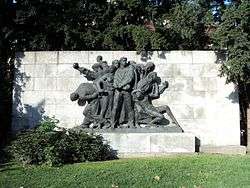
When World War II started, Zagreb was the capital of the newly formed autonomous Banovina of Croatia within the Kingdom of Yugoslavia, which remained neutral in the first years of the war. After the Invasion of Yugoslavia by Germany and Italy on 6 April 1941, German troops entered Zagreb on 10 April. On the same day, Slavko Kvaternik, a prominent member of the Ustaše movement, proclaimed the creation of the Independent State of Croatia (NDH), an Axis puppet state, with Zagreb as its capital. Ante Pavelić was proclaimed Poglavnik of NDH and Zagreb became the center of the Main Ustaša Headquarters, the Government of NDH, and other political and military institutions as well as the police and intelligence services.
Upon the establishment of NDH, the Ustaše enacted race laws and started persecuting Serbs, Jews and Roma. Thousands of locals, primarily Jews were killed in prisons and execution sites around the town, mainly in Dotršćina and Rakov Potok forests, or were taken to concentration camps and executed there.
After Germany's invasion of the Soviet Union, the Communist Party of Yugoslavia started an armed uprising against NDH. In January 1944 the 10th Zagreb Corps was formed that mainly operated in the wider Zagreb area and Northwest Croatia. The influx of refugees from war-ravaged areas of NDH nearly doubled the population of Zagreb. The Government of NDH left the city on 6 May 1945 and on 8 May Zagreb was liberated by the 45th, 28th and 39th divisions of the 2nd Army, and some units of the 1st Army of the Yugoslav Partisans. The Partisans then killed many captured soldiers and civilians accused of collaboration. In total more than 26,000 people from Zagreb lost their lives from 1941 to 1945.
On the occasion of 30th anniversary of the liberation of Zagreb, which was celebrated on 16 September 1975, the President of Yugoslavia, Josip Broz Tito, awarded the city of Zagreb with the Order of the People's Hero.
Banovina of Croatia
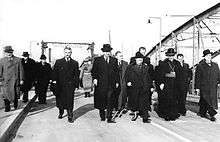
In August 1939, a week before the start of World War II, the autonomous Banovina of Croatia was formed under the Cvetković–Maček Agreement. Its capital was Zagreb and Ivan Šubašić was appointed ban of Croatia.[1]
In the 1930s, the most popular party among Croats was the Croatian Peasant Party (HSS), whose leader was Vladko Maček. In the late 1930s, the nationalist Ustaše movement experienced growth in popularity, but their membership remained low.[2] In July 1938, Mile Budak, the second most influential member of the movement, arrived in Zagreb and started the pro-Ustaše Hrvatski narod newspaper. The activities of the Ustaše increased in 1940, when the newspaper was banned.[3] The Communist party of Croatia, established in 1937 as a branch of the Communist party of Yugoslavia, also experienced growth in the late 1930s. However, HSS kept its dominance, especially among peasantry.[4] Both the Ustaše and the Communists opposed the Cvetković–Maček Agreement.[1]
In December 1939 a new railway bridge over Sava was opened by Croatian Ban Ivan Šubašić, HSS leader Vladko Maček and Archbishop Aloysius Stepinac.[5]
In August 1940, Zagreb hosted the 1st conference of the (KPH), which elected the Politburo and the Plenum of the Central Committee of the Communist Party, and in October 1940, the 5th conference of the League of Communists of Yugoslavia (KPJ).
Occupation and the establishment of NDH

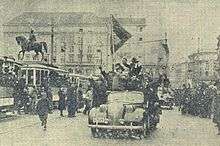
Germany put pressure on Yugoslavia to join the Tripartite Pact, which Prince Paul of Yugoslavia accepted on 25 March. However, demonstrations soon broke out against the decision and a coup d'état was launched on 27 March. Hitler took the coup as a personal insult and launched the invasion of Yugoslavia on 6 April 1941.[6] Most Croat soldiers in the Yugoslav Army did not feel Yugoslavia as their country and refused to fight for it.[7] Germans tried to persuade Maček to proclaim the independence of Croatia, but Maček refused it. They decided to support the Ustaše instead.[8]
On 8 April, a meeting of the Central Committee of the KPJ was held in Zagreb. It was attended by, among others, Josip Broz Tito, Rade Končar, Aleksandar Ranković, Marko Orešković, and Vladimir Bakarić. The meeting adopted the conclusion that the Yugoslav army has no chance to resist the Wehrmacht and that Party members should report immediately to the call for mobilization, but no armed resistance was organized in Zagreb.[9] KPJ members distributed about 10,000 leaflets in which they urged citizens of Zagreb to defend the country. On the same day, meeting of the Central Committee of KPJ was held on Tito's initiative. It concluded that Party delegation should be sent to the headquarters of the 4th Army in Zagreb and that they should request release of all political prisoners and weapons for workers and anti-fascists so they could fight against the aggressors. However, Command of the Military District refused to receive the delegation.[10][11]
On 10 April elements of the 14th Panzer Division entered Zagreb and were greeted by cheering crowds. Slavko Kvaternik declared the establishment of the Independent State of Croatia (Croatian: Nezavisna Država Hrvatska, NDH) via the Zagreb Radio Station, with Zagreb as its capital. Most of the population was pleased with the dissolution of Yugoslavia.[12][13] Kvaternik formed a provisional government in Zagreb on 12 April. Ante Pavelić, who was named the leader (Poglavnik) of NDH, arrived in Zagreb on 15 April. He gave a short speech in which he said: "Ustaše! We have won. We won because we had faith. We won because we held out. We won because we fought. Ustaše! We won because we were always Za dom spremni!"[14] Jozo Dumančić was temporarily named the Mayor of Zagreb, thus replacing Mate Starčević.[15]
When the NDH was proclaimed, the leadership of the Communist Party was in Zagreb, together with Josip Broz Tito. After a month, they left for Belgrade. Until 22 June, while the Molotov–Ribbentrop Pact between Germany and the Soviet Union was in effect, the Communists refrained from open conflict with the new regime. In the first two months of NDH they extended their underground network and began amassing weapons.[16]
On April 15, 1941, leaflet that contained a KPJ manifesto was duplicated and sent to all parts of Yugoslavia. The manifesto emphasized that the "Communists and the entire working class of Yugoslavia would be in the forefront of the national resistance against the invaders" and that "it would persist in the resistance until final victory".[17]
NDH rule in Zagreb

In early May 1941 Dumančić was replaced with Ivan Werner as Mayor of Zagreb, who stayed on that position until his death in June 1944.[18] In December 1941 there were anti-Italian protests in Zagreb against the Italian rule in Dalmatia. Stepinac also criticized the Treaties of Rome.[19] In April 1942 the Rebro Hospital was built.[20]
The new government gave particular importance to the Islamic community, especially the Bosnian Muslims which they viewed as Croat Muslims. The Meštrović Pavilion in the centre of Zagreb was turned into a mosque, with three minarets built around it.[21][22]
In May 1942, the Ustaše organized the Antisemitic Exhibition in Zagreb, and cinema screenings of German antisemitic propaganda films.[23] The exhibition also featured photographs of the various stages of the demolition of the Zagreb Synagogue, which had been located in the city centre and was destroyed in stages from October 1941 to April 1942.[24]
In June 1942 a new religious organisation was formed in Zagreb, the Croatian Orthodox Church. Germogen was named the Metropolitan of Zagreb and whole Croatia.[25]
The population of Zagreb constantly changed during the war as much of the civilian population from regions of NDH where military operations took place moved to Zagreb. At the end of 1941, Zagreb had 218,200 citizens. In the course of 1942, as thousands of refugees began pouring into the city, the population of Zagreb ranged from 350,000 to 400,000. At the beginning of 1944 the population of the city increased to around 417,000.[26]
Military
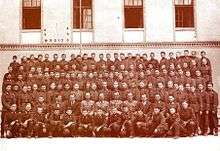
After NDH was proclaimed, the main armed forces were stationed in Zagreb, where three units were formed: The Poglavnik Bodyguard Battalion, First Ustaše Regiment and a Company of university students. Later the First Ustaše Regiment was separated into individual battalions.[27] The Croatian Home Guard officers' Academy was founded in Zagreb.[28]
In 1944, the armed forces of NDH were reorganized. Of the 18 standing brigades, the 10th and 25th were in Zagreb, together with the Poglavnik Bodyguard Brigade and the Zagreb Ustaše Brigade.[29] At the end of 1944, the Croatian Armed Forces were formed that unified the Croatian Home Guard and the Ustaše militia. The 1st Croatian Assault Division, 2nd Croatian Infantry Division, 16th Croatian Replacement Division and the Poglavnik Bodyguard Division were headquartered in Zagreb and operated in central and northwestern Croatia.[30] In December 1944, the Partisans estimated the strength of the 3 divisions at 7,000 (1st), 4,500 (2nd) and 9,500 (16th).[31]
War crimes
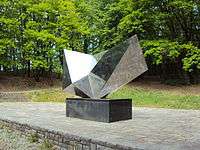

When Ustaše came to power, they immediately started to spread terror and to persecute their opponents. During the occupation, Ustaša inflicted abuse and torture of prisoners at several locations around the town, such as a notorious prison on Savska street, the prison on the Square N and a torture chamber in Jandrićeva street 74, popularly known as "Sing-Sing".
Ustaše commonly used the woods in Dotršćina, which was at the time located out of Zagreb, and Rakov Potok, a forest south of the Sava river and today's Novi Zagreb, as their execution sites. It is estimated that throughout the war Ustaše executed about 10,000 people in Dotršćina (2,000 of which were members of the SKJ and SKOJ),[32] and around 400 in Rakov Potok.[33]
From May 1941 onwards, the Ustaša regime enforced racial laws that put thousands of Zagreb's Serb, Jewish and Roma inhabitants at risk of death. By August 1941, the Jasenovac concentration camp was founded, and Zagreb was the main transit point for people being sent to the camp.
The executions of prisoners were made at the aforementioned execution sites in and near Zagreb, but as it became clear that the Axis were eventually going to lose the war, the Ustaše government ceased hiding for the killing of prisoners, so on December 20, 1943 they hanged a group of 16 antifascists on butcher hooks on a public street at the western end of Dubrava as a retaliation for the murder of an Ustaše agent Ljudevit Tiljk.[34] The victims of this crime became known as the "December victims". They were left hanging on poles for several days as a warning to other anti-fascists. It was the first public hanging of prisoners, a terror tactic that was afterwards used regularly by the Ustaše regime.
In 1944, Ustaše carried out several mass hangings and shootings in Vrapče, Kustošija (Črnomerec) and other locations. In early January 1945, when it was already clear that they would lose the war, Ustaše executed dozens of anti-fascists in Žitnjak from January 3 to 8.
Resistance organization
At the beginning of May 1941, a so-called May counseling of Communist Party officials from across the country, who sought to organize the resistance against the occupiers, was held in Zagreb. In June 1941, meeting of the Central Committee of KPJ, on which it was decided to start preparations for the uprising, was also held.[35] May Day proclamation of KPJ and proclamation of KPJ and KPH on the occasion of the Operation Barbarossa, were restored. In proclamation, all people were invited to the armed resistance, while all patriots were called into a united front for the expulsion of the invaders from the country. KPH remained in Zagreb until February 1942, when it moved to the liberated territory.[36]
The resistance movement in Zagreb was led by the Local Committee of the KPJ which had six rayon committees. At the beginning of the occupation, Zagreb KPJ organization had 53 basic organizations with about 500 members, of which 75% were workers. In addition, there was a strong Youth organisation, the "SKOJ", which, in the first half of 1942, had close to 900 members and about 500 supporters gathered in the boards of the League of the Young Generation. The association organized youth to fight against the occupiers on the anti-fascist platform and was later core of the United League of Antifascist Youth of Yugoslavia (USAOH).[37]
In October 1941, the Initiative Committee of the Women's Antifascist Front of Croatia (AFŽ) was established, at the end of 1941, the Central Committee of AFŽ, and in February 1942 Local Board of AFŽ.[38]
The most massive underground organization in occupied Zagreb was Narodna pomoć (lit. "People's help"), whose tasks included developing combat anti-fascist consciousness of the citizens, raising money and materials for the Partisans, assisting the families of soldiers, harboring illegal aliens, distributing illegal press, and transporting people to the liberated territory. This organisation's local committees were divided into six district committees, which in turn had a total of more than 700 members, and about 4,000 helpers and supporters. By 1943, Narodna pomoć was replaced by the National Liberation Committees.[39]
Notable sabotages in 1941
Soon after occupation, resistance movement organized a series of sabotages against the occupying forces. Ustaše tended to respond by carrying out acts of repression against prisoners in the case of anti-fascist sabotage or assassinations of German or Ustaša officials.
One of the first manifestations of resistance to the occupation was an action of solidarity of the Croatian youth with Jewish and Serbian youth that was conducted on May 26, 1941 at the Zagreb City Stadium when the leader of the Ustaša youth gave an inflammatory speech to the civil defense and called for Jews and Serbs to step forward which was essentially supposed to be an insight into the pogrom. When Jews and Serbs began to step forward, young members of SKOJ followed them, also pulling others with them so the pogrom was disabled. The 1977 movie "Operation Stadium" describes those events.
During June and early July 1941, the resistance sabotaged aerospace batteries in Prečko and storage of antiaircraft artillery in Ilica. It also organised the burglary of an ammunition train in the Zagreb Western railway station, as well as a diversionary attack on the railway lines to Varaždin, Sisak and Dugo Selo and Zagreb Radio station.
Kerestinec prison was a prison for the communists that was formed even during the government Cvetković–Maček. Upon coming to power, the Ustaše took over control of the prison, which had previously housed many communist intellectuals, among others August Cesarec, Božidar Adžija, Ognjen Prica, Otokar Keršovani, and Divko Budak.[40] In the night of 13–14 July 1941, KPJ activists organized an escape of detainees from Kerestinec, but because of poor coordination of operations it wasn't entirely successful, since only 14 of the 91 detainees managed to escape. Ustaše executed survivors in Maksimir and Dotršćina on the next day, including Adžija, Cesarec and Prica.[41][42]
In July, the resistance sabotaged a silk factory, where it burned 50,000 meters of parachute silk. A few days later, SKOJ members set fire to wooden parts of Maksimir Stadium, whose panels the Ustaše had intended to use for the construction of concentration camp barracks.
The first major armed action prepared by the KPJ, SKOJ, students and workers, was the one conducted near Zagreb Botanical Garden. On July 14, 1941, 12 resistance movement members, led by Slavko Komar, attacked the members of an Ustaša university company with hand grenades and revolvers, injuring 28 of them. The Ustaša government reacted to this attack with severe reprisals. On August 5, it was announced that 4 attackers were executed. "In addition, 98 Jews and Communists were sentenced to death by the Senate of the Court Martial as accomplices and intellectual pioneers of the attack."[43] On the following day, August 6, execution of additional "87 Jews and Communists" as "further accomplices and intellectual originators of the attack " was announced.[44] Radio Moscow reported in an special emission that the Ustaše executed 305 people.[45]
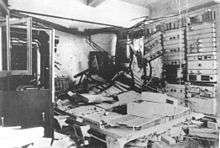
In September 1941, a group of anti-fascists attacked a bus with German soldiers in Zvonimirova street. In the same month, there was also a sabotage in Cement factory in Podsused.
On September 14, a group of anti-fascists, led by Viliam Galjer, conducted a long-prepared Sabotage at the General Post Office in Zagreb, when explosives damaged automatic exchange device and high-frequency device for long distance communication.
On the same day, a detachment of Ustaše was attacked in Vrbanićeva street, and on September 30, anti-fascists, led by Ivan Šibl, attacked a group of German airmen in Rusanova street.
Partisan military unit organization
The first Zagreb-Sesvete partisan group was formed in Dubrava in July 1941. In August 1941, a group of fighters from Zagreb traveled to Žumberak where they formed a partisan unit "Matija Gubec", which had 37 members, but after it was attacked by the much stronger enemy forces it was dissolved.
The first partisan unit in the nearby Hrvatsko Zagorje was formed in March 1942 near the village Brdovec, roughly 15 kilometres (9.3 mi) northwest of Zagreb. In April 1942, a tenth of fighters was sent from Zagreb to Žumberak where they merged with the First Zagorje unit, after which they grew into the "Josip Kraš" Battalion.
In the summer of the same year, the first partisan units were formed in Moslavina (roughly 75 km (47 mi) southeast of Zagreb), and in the fall the first partisan unit was formed at Kalnik (roughly 50 km (31 mi) northeast of Zagreb).
At the end of November 1942, the "Pokupsko-Žumberak unit" and the "First Battalion of the Croatian proletarian" merged into the 13th strike brigade "Josip Kraš" (later named "Rade Končar"). In August 1943, the "Brothers Radić" Brigade was formed, and in the fall of the same year "Matija Gubec" Brigade.
In July and October 1943, the Partisans entered Gornje Vrapče neighborhood, in what was then the immediate vicinity of Zagreb, and also penetrated the Sljeme mountain. In December of the same year, the Turopolje unit attacked the main aviation depot in Sopnica near Sesvete while on December 19 the 18th Slavonia unit destroyed the airport Kurilovec.
The 10th Zagreb Corps was formed in January 1944. Upon formation it had around 7,000 fighters. At the end of 1944 the Corps had 9,859 soldiers and officers.[46] It became the carrier of fighting actions in northwestern Croatia and especially in the Zagreb district. In late January 1944, the Youth Brigade "Joza Vlahović" and the "Franjo Ogulinac Seljo" Brigade of the 34th Division were formed. In the fall of the same year, so were the Ljubljana Brigade "Pavlek Miškina" and the Brigade "Nikola Demonja".
Allied bombing campaigns
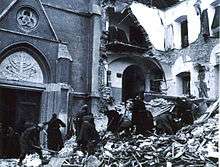
The bombing of Zagreb began in February 1944. The objectives of the bombing campaigns were railroads, railway stations and nearby airports, but the city did not sustain major damage, except for a smaller number of residential buildings in the suburbs.[47] According to a victims list conducted in 1950, 404 people were killed in the Zagreb region and 327 people in the city of Zagreb, with no indication whether the bombings were carried out by Allied or Axis forces.[48]
End of the war

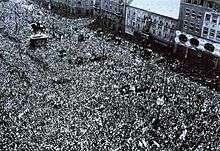
In early May 1945, Zagreb was defended by parts of the 1st Division of the Army of NDH and the 41st and 181st German Divisions, deployed along the unfinished fortified "Zvonimir line" between Sveti Ivan Žabno and Ivanić-Grad. The fierce battle with the 1st Army of the People's Liberation Army of Yugoslavia lasted from 5 May to 8 May. The 7 May was the single bloodiest day in the 1,240-day long history of the 1st Proletarian Brigade, with 158 killed and 358 wounded in the fighting for Vrbovec.[49]
In the last days of the war, the city had nearly 500,000 civilians.[26] On 6 May 1945, the collaborationist government of the Independent State of Croatia fled Zagreb. On 7 May 1945, Germany surrendered unconditionally to the Allied powers, marking the formal end of World War II in Europe.[50]
On 7 May, brigades of the 45th Serbian Division, 28th Slavonia Division and 39th Krajina Division of the 2nd Army were on the outskirts of Zagreb.[51] First Partisan units from the 45th and 28th Division entered the deserted streets of Zagreb on 8 May at 11 AM.[52][53] There were relatively few skirmishes and casualties in the city itself. There were groups of soldiers that surrendered or were captured, many of which were immediately shot. The 1st Army reported to the General Staff that 10,901 enemy soldiers had been killed and 15,892 captured in taking Zagreb.[54] Partisan radio broadcast about the continuous street fighting. The 2nd Army had many Serbs and Montenegrins in its ranks and former Chetniks that were granted amnesty, so most of the population of Zagreb stayed in their homes.[52] The commanders of the 10th Zagreb Corps were disappointed that the 10th Corps was not the first one to enter Zagreb. Colonel Ivan Šibl wrote about it in his diary:[55]
"We felt tricked and cheated. We are still not real soldiers and none of us were satisfied with the knowledge that the battle for Zagreb was already won, in many battles and skirmishes in which our brigades also participated. We were supposed to get there first, but we arrive last to a peaceful, free city. They simply tricked us!"
A few days later, when forces of the 10th Zagreb Corps arrived to the city, people gathered in the Jelačić Square and gave them a triumphant welcome.[52] Journalist and historian Josip Horvat observed the liberation of Zagreb in May 1945:
"I walked through Tuškanac. While walking I laughed like a child - for four years and one month you couldn't go through there. On this little thing I felt that freedom came, that we are entering into a new life. It's so weird at the heart, man with his brain does not realize that fear is gone. (...) Newly arrived army still goes through town, all torn up, but excellently armed, real fighters."[56]
After the liberation of Zagreb, Yugoslav People's Army units continued their march towards the enemy forces who fled towards Klanjec and Krško in Slovenia. The pursuit of the Ustaše-led column continued through Slovenia, and ended at the border with Austria, resulting in the Bleiburg repatriations.[57]
Aftermath
From 1941 to 1945, 3,335 people from Zagreb died in the wider Zagreb area in prisons, on the streets, in reprisals and mass terror, 5,293 died in camps (3,264 of them in Jasenovac), and 1,852 in camps outside Yugoslavia, while 1,141 died in reprisals, shootings, prisons and mass terror outside Zagreb. 4,162 died as members of the NOVJ.[58] Around 8,000 died as members of NDH forces, in allied bombing campaigns of the city or in reprisals after the war.[59] The exact number of people from Zagreb that actively participated in partisan units is not known, Yugoslav historians estimated that there were tens of thousands of them.[60]
89 people of Zagreb were declared People's Hero, while 600 were awarded Commemorative Medal of the Partisans of 1941.
While presenting the Order of the People's Hero on September 16, 1975, marshal Josip Broz Tito, President of Yugoslavia, who was also one of the main carriers of the Zagreb resistance movement, stated:
"Order of the People's Hero which I am presenting today to Zagreb symbolizes the recognition of all the participants of revolutionary events, to all of those who contributed to our victory and the construction of socialism, and especially those who bravely and unselfishly gave their lives in that fight."
Notes
- 1 2 Tanner 2001, p. 133.
- ↑ Tomasevich 2001, p. 337.
- ↑ Tomasevich 2001, p. 40.
- ↑ Tomasevich 2001, p. 360.
- ↑ Horvat 1942, p. 137.
- ↑ Goldstein 1999, p. 131.
- ↑ Krizman 1978, p. 394.
- ↑ Ramet 2006, p. 111.
- ↑ Lengel-Krizman 1980, p. 101.
- ↑ "prveakcijekomunistauokupiranomgradu - zagrebsebori". Sites.google.com. Retrieved 2016-07-02.
- ↑ "75. OBLJETNICA NDH: ROĐENJE, ŽIVOT I SLOM ZLOČINAČKE DRŽAVE Na današnji dan nacisti su ušli u Zagreb. Goebbels je pisao o velikom slavlju Hrvata, a Tito je bio bijesan... -Jutarnji List". Jutarnji.hr. 2016-04-09. Retrieved 2016-07-02.
- ↑ Tanner 2001, p. 142.
- ↑ Goldstein 1999, p. 133.
- ↑ Tanner 2001, p. 143-144.
- ↑ Stuparić 1997, p. 106.
- ↑ Goldstein 1999, p. 140.
- ↑ "Prvi ratni proglas CK KPJ narodima Jugoslavije" (PDF). Fond CKKPJ. 1941.
- ↑ Stuparić 1997, p. 427.
- ↑ Ramet 2006, p. 128.
- ↑ Stuparić 1997, p. 266.
- ↑ Matković 2002, p. 132.
- ↑ Tanner 2001, p. 149.
- ↑ "Preko 8,000 osoba posjetilo je izložbu "Židovi" u 4 dana". Nova Hrvatska (in Croatian). Zagreb, Independent State of Croatia: Ustaški nakladni zavod. 5 May 1942.
- ↑ Knežević, Snješka (2001). "The Synagogue of Zagreb, 1867–1942" (PDF). The Synagogue and Zagreb. Jewish Community of Zagreb. pp. 42–46. Retrieved 2010-02-26.
- ↑ Matković 2002, p. 131.
- 1 2 Lengel-Krizman 1980, p. 53.
- ↑ Boban 1977, p. 1045.
- ↑ Matković 2002, p. 101.
- ↑ Boban 1977, p. 1046.
- ↑ Boban 1977, p. 1049-1050.
- ↑ Zbornik dokumenata 1968, p. 535.
- ↑ Stipe Ugarković- Ivan Očak, Zagreb grad heroj-Spomen obilježja revoluciji, August Cesarec, Zagreb 1979, p. 135-139
- ↑ http://www.znaci.net/00001/217_4.pdf
- ↑ Ivo Goldstein, Zagreb 1941-1945, „Novi Liber“, Zagreb 2011, p. 272-273
- ↑ Davor Marijan, The May Deliberations of the Central Committee of the Communist Party of Yugoslavia, Hrvatski institut za povijest, 2003, p. 325-331, ISBN 953-6324-35-0
- ↑ "Okupacija i pripreme za ustanak | Partizani". Izlozba.sabh.hr. Retrieved 2016-07-02.
- ↑ Mihajlo Ogrizović, Obrazovanje i odgoj mlade generacije i odraslih u Slavoniji za vrijeme NOB, Radovi Zavoda za hrvatsku povijest Filozofskoga fakulteta Sveučilišta u Zagrebu, Vol.1 No.1, March 1972
- ↑ http://arhinet.arhiv.hr/_Pages/PdfFile.aspx?Id=900
- ↑ "Muzej grada Zagreba - 41. Drugi svjetski rat". Mgz.hr. Retrieved 2016-07-02.
- ↑ Ivo Goldštajn, Zagreb 1941-1945, „Novi Liber“, Zagreb 2011, p. 115-116.
- ↑ "Death camps in Yugoslavia". Vojska.net. Retrieved 2016-07-02.
- ↑ "Dotrscina". Dotrscina.hr. Retrieved 2016-07-02.
- ↑ p. 328
- ↑ p. 330
- ↑ "oružaneakcijeidiverzije - zagrebsebori". Sites.google.com. Retrieved 2016-07-02.
- ↑ Boban 1977, p. 88.
- ↑ Lengel-Krizman 1980, p. 91.
- ↑ Karakaš 2007, p. 74-75.
- ↑ Miladinović 1991, p. 1187.
- ↑ Tomasevich 2001, p. 755.
- ↑ Dželebdžić 1989, p. 356.
- 1 2 3 Tanner 2001, p. 168.
- ↑ Dželebdžić 1989, p. 357.
- ↑ Dizdar 2005, p. 134.
- ↑ Šibl 1966, p. 421.
- ↑ http://znaci.net/00002/423.pdf
- ↑ Dizdar 2005, p. 136.
- ↑ Dizdar 1989, p. 147.
- ↑ Goldstein 2011, p. 391.
- ↑ Bilandžić 1968, p. 60.
References
- Books and journals
- Bilandžić, Dušan (1968). Revolucionarni radnički pokret u Zagrebu između dva svjetska rata [The revolutionary workers' movement in Zagreb between the two world wars]. Institut za historiju radničkog pokret Hrvatske.
- Boban, Ljubo (1977). Sjeverozapadna Hrvatska u NOB-u i socijalističkoj revoluciji [Northwestern Croatia in the NOB and socialist revolution]. Zajednica općina memorijalnog područja Kalnik.
- Dizdar, Zdravko (November 1989). "Logor Kerestinec" [Kerestinec Camp]. Historical contributions (in Croatian). Zagreb, Croatia: Institut za historiju radničkog pokreta Hrvatske. 8 (8): 143–192.
- Dizdar, Zdravko (December 2005). "Prilog istraživanju problema Bleiburga i križnih putova (u povodu 60. obljetnice)" [An addition to the research of the problem of Bleiburg and the Way of the Cross (dedicated to their 60th anniversary)]. The Review of Senj (in Croatian). Senj, Croatia: City Museum Senj - Senj Museum Society. 32 (1): 117–193. ISSN 0582-673X.
- Dželebdžić, Milovan (1989). Druga jugoslovenska armija [Second Yugoslav Army]. Belgrade: Vojnoizdavački i novinski centar.
- Goldstein, Ivo (1999). Croatia: A History. London: C. Hurst & Co. ISBN 978-1-85065-525-1.
- Goldstein, Ivo (2011). Zagreb 1941-1945. Zagreb: Novi liber. ISBN 9789533250113.
- Horvat, Rudolf (1942). Zagreb: povijest hrvatskoga glavnog grada [Zagreb: history of the Croatian capital city]. Zagreb: Hrvatsko književno društvo Sv. Jeronima.
- Karakaš, Marica (December 2007). "Žrtve saveznickih bombardiranja Nezavisne Države Hrvatske u jugoslavenskim popisma žrtava rata (1947., 1950. i 1964.) i hrvatskim žrtvoslovima (1991.-2005.)". Polemos: Journal of Interdisciplinary Research on War and Peace. 10 (20).
- Krizman, Bogdan (1978). Pavelić i ustaše [Pavelić and the Ustaše]. Zagreb: Globus.
- Lengel-Krizman, Narcisa (1980). Zagreb u NOB-u [Zagreb in NOB]. Zagreb: Globus.
- Matković, Hrvoje (2002). Povijest Nezavisne Države Hrvatske [History of the Independent State of Croatia] (in Croatian). Naklada Pavičić. ISBN 953-6308-39-8.
- Miladinović, Veljko (1991). Prva proleterska. Knj. 4 [1st Proletarian Brigade. Book 4]. Beograd: Vojnoizdavački zavod JNA "Vojno delo". OCLC 441105996.
- Ramet, Sabrina P. (2006). The Three Yugoslavias: State-Building and Legitimation, 1918–2005. Bloomington: Indiana University Press. ISBN 978-0-253-34656-8.
- Stuparić, Darko (1997). Tko je tko u NDH: Hrvatska 1941.–1945. [Who is who in NDH: Croatia 1941-1945]. Zagreb: Minerva. ISBN 953-6377-03-9.
- Šibl, Ivan (1966). Ratni dnevnik [War Diary]. Naprijed.
- Tanner, Marcus (2001). Croatia: A Nation Forged in War. New Haven: Yale University Press. ISBN 978-0-300-09125-0.
- Tomasevich, Jozo (2001). War and Revolution in Yugoslavia, 1941–1945: Occupation and Collaboration. Stanford Univ: Stanford University Press. ISBN 978-0-8047-3615-2.
- Zbornik dokumenata i podataka o narodnooslobodilačkom ratu naroda Jugoslavija - Tom V, Knjiga 36 - Borbe u Hrvatskoj 1941. god. Belgrade: Vojnoistorijski institut. 1968.
